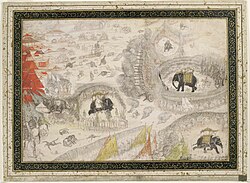Mughal War of Succession (1658–1659)
This article or section is in the process of an expansion or major restructuring. You are welcome to assist in its construction by editing it as well. If this article or section has not been edited in several days, please remove this template. If you are the editor who added this template and you are actively editing, please be sure to replace this template with {{in use}} during the active editing session. Click on the link for template parameters to use.
This article was last edited by Ajay Kumar (talk | contribs) 2 years ago. (Update timer) |
| Mughal War of Succession (1658–1659) | |||||||||
|---|---|---|---|---|---|---|---|---|---|
| |||||||||
| Belligerents | |||||||||
|
|
| Shah Shuja's forces | Murad Bakhsh's forces | ||||||
The Mughal War of Succession (1658–1659) was a war of succession fought between the four sons of Shah Jahan: Aurangzeb, Dara Shikoh, Murad Bakhsh, and Shah Shuja, in hopes of gaining the Mughal Throne. Prior to the death of Shah Jahan, each of his sions held governorships during their father's reign. The emperor favoured the eldest, Dara Shikoh, However, there was resentment among the younger three, who sought at various times to strengthen alliances between themselves and against Dara.[1] Since there was no Mughal tradition of primogeniture, the systematic passing of rule, upon an emperor's death, to his eldest son.[2] Instead it was customary for sons to overthrow their father and for brothers to war to the death among themselves.[3]
Shah Shuja was victorious in the Battle of Bahadurpur, Shuja turned back to Rajmahal to make further preparations. He signed a treaty with his elder brother, Dara, which left him in control of Bengal, Orissa and a large part of Bihar, on 17 May 1658.
Aurangzeb defeated Dara twice (at Dharmat and Samugarh), caught him, executed him on a charge of heresy and ascended the throne. Shuja marched to the capital again, this time against Aurangzeb. A battle took place on 5 January 1659 at the Battle of Khajwa (Fatehpur district, Uttar Pradesh, India), where Shuja was defeated. Ultimately, Aurangzeb was victorious making him the 6th Mughal Emperor.[4]
Background[edit]
Battle of Bahadurpur[edit]
Battle of Dharmat[edit]
Battle of Samugarh[edit]

After his defeat at the Battle of Dharmat, Dara Shikoh began to retreat towards Samugarh, about 10 miles (16 km) east of Agra, south of the Yamuna River, Aurangzeb and his army then flanked Dara’s fortified line along the Chambal River.[5]
Shikoh ordered his cannons to start firing towards the army of Aurangzeb. Eventually, Murad Baksh and his Sowars began a swift charge into the far right flank of Dara Shikoh, commanded by Chatter Sal, without the orders of Aurangzeb. It is believed that Murad Baksh was a sworn enemy of Chattar Sal. They both fought ferociously on the battlefield as the Sowars of Murad Baksh and Murad Baksh killed Ram Singh Rautela.[citation needed]
When Dara Shikoh was informed about the death of Chattar Sal, Murad Baksh,[6] the collapse of the Rajput infantry and the Deccan Sowars, he immediately pushed towards their aid alongside Khalilullah Khan. However, Due to Aurangzeb's heavy bombardment Dara Shikoh decided to join Khalilullah Khan in the Cavalry. Dara Shikoh’s army fled to Goindwal where Guru Har Rai had deployed his army, the Akal Sena, to prevent and delay Aurangzeb’s army from pursuing Dara Shikoh.[7] When the battle ended Dara Shikoh and Khalilullah Khan fled towards Sulaiman Shikoh and Aurangzeb was declared the new Mughal Emperor.
Battle of Khajwa[edit]
Coronation of Aurangzeb[edit]
References[edit]
- ↑ Mukhoty, Ira. "Aurangzeb and Dara Shikoh's fight for the throne was entwined with the rivalry of their two sisters". Scroll.in.
- ↑ Chandra, Satish (2005). Medieval India: From Sultanat to the Mughals. Vol. 2. Har-Anand Publications. pp. 267–269. ISBN 9788124110669. Retrieved 29 September 2012.
- ↑ Markovits, Claude, ed. (2004) [First published 1994 as Histoire de l'Inde Moderne]. A History of Modern India, 1480–1950 (2nd ed.). London: Anthem Press. p. 96. ISBN 978-1-84331-004-4.
- ↑ Catherine Blanshard Asher, (1992) "Architecture of Mughal India – Part 1", Cambridge university Press, Volume 1, Page 252.
- ↑ Sarkar 1973, Aurengzeb Thanks Allah for his victory pp. 231.
- ↑ Lal, M. (1988). Aurangzeb. Vikas Pub. House. Retrieved 2015-02-22.
- ↑ Takhar, Opinderjit Opinderjit; Jakobsh, Doris R. (2023). Global Sikhs: Histories, Practices and Identities. Routledge Critical Sikh Studies. Taylor & Francis. ISBN 9781000847352.
During the time of the seventh Guru, the emphasis on armed conflict with the Mughals receded, but Guru Har Rai held court and kept a regular force of Sikh horsemen. He had favorable relations with Dara Shikoh (eldest son of Emperor Shah Jahan and heir apparent to the Mughal throne), who sought the Guru's help while he was fleeing in front of the army of his younger brother Aurangzeb, after his defeat in the battle of Samugrah on May 29, 1658. According to Mahimà Prakäsh Värtak, Guru Har Rai deployed his own troops at the ferry at Goindval to delay Aurangzeb's army, which was pursuing Dara Shikoh at his heels